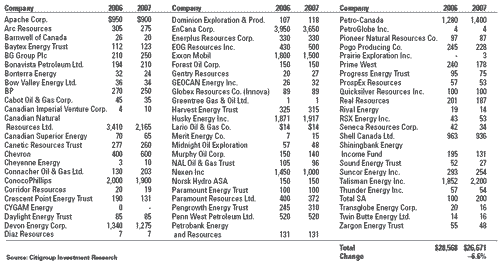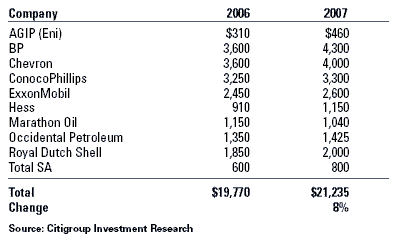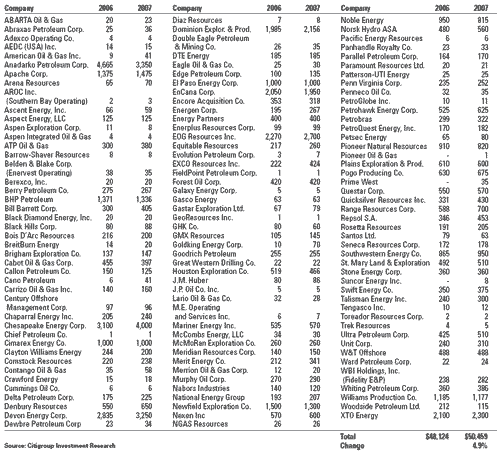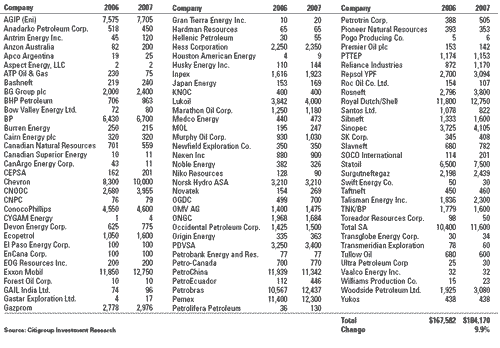Outlook 2007 E&P Spending
Oil industry spending plans grow by 7%
Outside North America expands 9.9% over 2006 expenditures.
Geoff Kieburtz, Michael McNair, Jon Starks and Dino Sadikovic, Citigroup
Citigroup Investment Research, a division of Citigroup Global Markets Inc., published its 25th annual E&P Spending Survey on Dec. 14, 2006. The 40-page report includes responses from 237 oil and gas companies (up from 196 in 2005), and analyzes spending for 2006 and plans for 2007, focusing on the US, Canada and regions outside North America. The data include 52 tables and figures plus CIR’s comments, survey highlights, the survey’s process and results, and company observations.
The authors say the survey forecasts expenditures to grow 7% to $282.6 billion in 2007 from $264.0 billion in 2006. North American spending is expected to be up 2.1%, to $98.5 billion. This includes a 5.7% increase in the US, to $71.8 billion, and a decrease of 6.6% in Canada, to $26.7 billion. Outside North America, plans for spending $184.2 billion represent a 9.9% increase over 2006 expenditures. Increased international investment programs are driven by a mix of major and national oil companies.
The estimate for actual spending growth in 2006 is now 26.4%, compared to an initial estimate of 14.1%. Initial 2006 plans were overspent in every region, resulting in 37.8% growth in US spending, 15.6% in Canada, and 24.2% outside North America.
The authors estimate that 2006 plans incorporated 15% price inflation for services and drilling in last year’s survey. Numerous respondents said prices rose more than expected over the past year, primarily in North America. Most operators expect price inflation to slow in 2007 and have reflected this in spending plans. Some operators decided to cut spending deeply to precipitate price reductions from the service providers. This approach is common among the large operators in Canada, where price increases are seen as excessive. By contrast, several large operators said oilfield pricing is just catching up with the rise in oil and gas prices over the past years, and that project economics remain compelling. The authors believe this signals a new phase with price increases and margins more closely linked to field performance.
Average oil price assumptions for 2007 increased to $57.05/bbl from $49.51/bbl in 2006. This compares with a futures strip price increase to $65.54 from $63.00 over the same period. Natural gas price assumptions for 2007 declined to about $7/Mcf from $8/Mcf last year. The current futures strip price is near $8/Mcf, compared to more than $12/Mcf a year ago after the hurricanes.
| 2006�2007 Canadian E&P expenditures, $ millions |
 |
|
Survey highlights. The growth projection makes 2007 the eighth consecutive year of increased spending. This is the longest sustained cycle the industry has seen in more than 25 years. The projected 5.7% increase in US spending for 2007 compares with an estimated 38% spending growth in 2006, up from an initial projection of 16.5%. For 2007, the number of respondents planning to increase spending outnumbered three to one those planning a decrease.
The 6.6% decline in Canadian expenditures forecast for 2007 follows an estimated 15.6% increase in 2006, up from an initial estimate of 12.0% for 2006. The number of respondents planning reduced expenditures in Canada is double those planning to raise 2007 spending.
Respondents with activity outside North America plan a 9.9% increase in 2007 after a 24.2% increase in 2006. The 2006 forecast was for a 13.6% rise in expenditures. For 2007, the number of respondents planning an increase outnumbers those planning spending cuts by more than three-to-one and accounts for almost two-thirds of all respondents in this category.
| 2006�2007 US expenditures by major oil & gas companies, $ millions |
 |
|
A pattern of overspending initial plans has emerged over the past several years, in contrast to data from the survey during the 1980s and 1990s. The authors believe this pattern reflects an important feature of the current cycle: Operators maintained a disciplined response to higher oil and gas prices, and to higher oilfield prices. This reduces the likelihood of severe corrections and prolongs the cycle.
A regional divergence on oilfield pricing trends is emerging that is consistent with the shift in spending growth. More than half the respondents in North America expect oilfield price stabilization in 2007, and only one-third expect significant increases. By contrast, almost 70% of respondents outside North America expect pricing to increase significantly. More than two-thirds believe service and drilling prices have a significant impact on E&P spending plans, compared to less than half last year.
The ultimate source of contractors’ pricing leverage is the capacity shortage. A year ago, the authors asked if capacity constraints would limit spending increases in 2006. A record 80% of respondents expressed concern about land and offshore drilling rig availability, and 60% said skilled personnel were in short supply. The industry has seen significant investment in new equipment, and the number of respondents concerned about rig availability has dropped to 65%. However, the people issue has intensified, with 85% of respondents now concerned about the shortage of qualified personnel.
This survey continued a two-year-old trend of increased emphasis on exploration activity. The shift has not been dramatic, but it is persistent. This is mirrored in increased spending on seismic data collection and interpretation. Almost twice as many respondents plan increases in exploration as a percentage of planned spending, compared to those with a greater emphasis on development work. The number of respondents with increased seismic expenditures is three times the number planning to reduce seismic spending.
Drilling technology took over as the most important technology, displacing seismic, which was the most frequently mentioned technology over the past 10 years. The shift is important for the service industry. Respondents mentioned directional drilling (56%), seismic (54%) and fracturing technology (50%).
Of the planned 2007 spending, 65% is targeted for international projects, 25% is directed at the US and 9% is slated for Canada. The largest component of industry spending that is not included in the survey comes from Middle Eastern national oil companies, where reliable data has not been available.
US independents. In the US, the 131 independents surveyed plan a 4.9% increase in 2007 upstream expenditures, to $50.5 billion. This compares with an estimated growth rate of 40.8% in 2006 and actual growth of 41.1% in 2005. The sharp slowdown in spending growth is due to natural gas price volatility, record high gas storage, and increased oil service and drilling prices. It is worth noting that initial spending plans in 2006 (+18.6%) and 2005 (+9.7%) were conservative; the authors believe the upside potential of initial plans is more subdued.
| 2006-2007 US expenditures by independents, $ millions |
 |
|
On the positive side, operators have very strong balance sheets, and there is acute awareness that even a modest drilling decline will likely precipitate a production fall. The resulting gas price rebound could recreate capacity shortages. Pricing sensitivity is skewed to the upside for both natural gas and oil.
The largest spending increases are projected to come from Chesapeake Energy ($900 million), EOG Resources ($430 million) and Devon Energy ($415 million). Conversely, the largest declines are anticipated from Anadarko Petroleum ($1,315 million) and Newfield Exploration ($200 million).
US majors. The ten companies that the authors designate as major oil companies are planning a 7.4% increase in worldwide upstream expenditures in 2007, to $97.8 billion. Within this group, only Marathon’s estimates are lower in 2007 than in 2006. The modest reduction is the result of project timing. The largest estimated increase is from Chevron, and accounts for about one-third of the majors’ total increase.
Canada. In 2007, the authors expect the Canadian rig count to decrease 10%, in line with the spending reduction. Of the companies responding, 56% expect lower spending, 28% expect higher spending, and 16% expect no change, for a total decrease of $1.9 billion. Ten companies expect to decrease spending by $50 million or more, while only seven companies expect to increase spending by $50 million or more.
For 2007, the largest incremental spending decreases are anticipated from Canadian Natural Resources ($1,245 million), Nexen ($450 million), EnCana ($300 million), ExxonMobil ($300 million) and ConocoPhillips ($100 million). The biggest increases are at Talisman Energy ($348 million), Chevron ($200 million), Petro-Canada ($120 million) and Total SA ($100 million).
International. Outside North America, the 99 companies surveyed plan a 2007 spending increase of 9.9%, to $184.2 billion. Of the respondents, 67% expect higher spending, 20% expect lower spending and 23% expect no change, for a total increase of nearly $17 billion.
Seven companies expect to increase spending by $1 billion or more, while only six companies expect to decrease spending by $100 million or more. The largest spending increases for 2007 are by Petrobras ($1,870 million), Chevron ($1,700 million), CNOOC ($1,275 million), Total SA ($1,200 million), Woodside ($1,155 million), Rosneft ($1,000 million) and Statoil ($1,000 million). The largest decreases are planned by PetroChina ($597 million), ONGC ($284 million), Santos ($256 million), TNK/BP ($179 million), ATP ($155 million) and Canadian Natural Resources ($142 million).
| 2006�2007 International (outside North America) E&P expenditures, $ millions |
 |
|
Key observations. US spending figures for 2006 are expected to increase to 37.8%, a survey record, surpassing the 1999 high of 36.6%. Canada’s 15.6% spending growth in 2006 is significantly higher than prior forecasts. Outside North America, the expected 2006 spending increase of 24.2% is much higher than the original forecast of 13.6%. With commodity prices at historic highs, many operators are still spending within their operational cash flows.
Over the past five years, as commodity prices rose steadily to record levels, overall spending exceeded expectations. The proportion of respondents who overspent their original plans was 72%, below last year’s 74% but above the 68%–69% range of 2003–04.
• With commodity prices relatively high, the availability of attractive drilling prospects remained the most important factor in spending plans, as 53% of respondents noted. High commodity prices continued to generate prospect demand.
• Operating cash flows have become a more important factor in E&P spending—43% of respondents listed it as a major driver compared with 40% last year. More oil and gas companies overspent their cash flow than underspent in 2006. This was the first time in seven years that a majority of companies spent beyond their cash flow. For 2007, companies intend to underspend their cash flows because commodity prices appear sustainable.
• The availability of skilled personnel is also an increasingly important driver for North American operators. The authors believe the ability to hire and retain skilled personnel will determine the expansion or curtailment of spending plans.
• The average oil price assumption for 2007 is $57.05/bbl, up more than $7.50 from 2006’s record response and 142% above the $23.60/bbl average for the previous 15 years The greatest increases came from outside North America (up $8.70) and US independents (up $8). The majors responded with a $6.50 increase from last year.
• The long-term oil price expectation has seen a step change. The long-term assumption of $53.68/bbl across all respondent categories is $9.68/bbl above last year’s response. Optimism was greatest from the US independents, with a price increase of more than $12/bbl over last year’s forecast, while the US majors’ assumption slowed to a $6/bbl increase this year versus a $15/bbl increase last year.
• After recent years of record high prices, companies have more financial flexibility and are less sensitive to commodity price changes.
• US natural gas price assumptions declined by almost 14% to $6.93/Mcf from last year’s $8.03/Mcf response. The authors believe the decrease is driven by decline in the natural gas forward strip because of record high storage levels and milder-than-expected weather, and the expectation that such conditions may persist near term.
• This year, 40% of US independents, 25% of US majors and 35% of Canadians had reduced outlooks. Only 13% of the respondents indicated that they would raise their spending budgets if gas prices averaged $0.60/Mcf higher than they expect, about in line with last year. At $1.50/Mcf and $3/Mcf, pricing sensitivity is increasing, with 35% of respondents saying a $1.50 increase would affect their spending levels, above last year’s 28%, and 64% reacting to a $3 increase, up from 49%.
• With oil prices holding stronger than natural gas prices, operators view oil drilling as more attractive than natural gas drilling. In the survey, 41% of worldwide respondents indicated that they would shift toward oil, up from 21% a year ago. The shift is most dramatic in Canada, where 44% indicated they would move toward oil, compared with 17% a year ago. In the US, 34% indicated they will shift toward oil, compared with 13% last year. Outside North America, significantly more respondents shifted toward oil projects in 2006, and an even greater shift is expected in 2007.
• The trend toward exploration that began in 2003 is intact and accelerating, with the exception of Canada, where it is decelerating. US respondents (43%) expect to shift toward exploration, up from 33% last year. This acceleration is pronounced outside of North America, where 50% of respondents expect greater exploration activity next year, up from 27% a year ago.
• There is a mixed picture for offshore/onshore spending. US respondents (35%) indicated a shift toward onshore spending. Outside North America, 39% expect to shift their spending toward offshore. The authors believe relatively high commodity prices led to a preference for land drilling in the US because wells are less costly to develop and land production infrastructure is more widespread, so operators can get their product to market more quickly.
• More respondents will increase their spending on seismic. Worldwide, 44% plan to increase seismic spending in 2007, versus 14% decreasing. Seismic spending for production activities is increasing.
• The percentage of respondents finding drilling more favorable than buying reserves (89%) remains high, though that number is down from 93% last year. Given oil prices above $60/bbl and gas prices in excess of $7/Mcf, acquisition prices have increased significantly, making growth through the drill bit more attractive. The bias remains toward purchasing natural gas reserves.
• In the US, 57% of respondents rated oil exploration economics good to excellent, down from 70% a year ago. Natural gas exploration continues to be attractive, with 67% rating it good to excellent, down from 80% a year ago. In Canada, 58% of respondents rated oil exploration economics favorable, down from 69% a year ago, while the percentage favoring natural gas declined to 61% from 79% last year. Outside North America, economics for both oil and gas were rated less favorably than a year ago, but overall the view remains positive.
• Finding and development (F&D) costs continued their upward trend in 2006, with 81% of respondents experiencing higher costs, up from 80% in 2006 and representing the highest percentage since 1996. Increases in F&D costs are broadly based; pricing pressures that began in North America in 2004 seem to have expanded to international markets.
• Concerns about the lack of capacity or qualified personnel remain elevated, especially for drilling rigs. Operators are challenged in their efforts to find qualified people: 40% of respondents cited personnel as a concern, up from 26% a year ago.
Given the strong commodity price environment, optimism in the oil patch remains at a high level. Overall, 97% of respondents have a favorable three-year outlook, roughly in line with the previous seven years. 
Note: Citigroup Investment Research cautions that it is not statistically accurate to compare total estimates with those from prior years because the companies surveyed vary from year to year.
|






